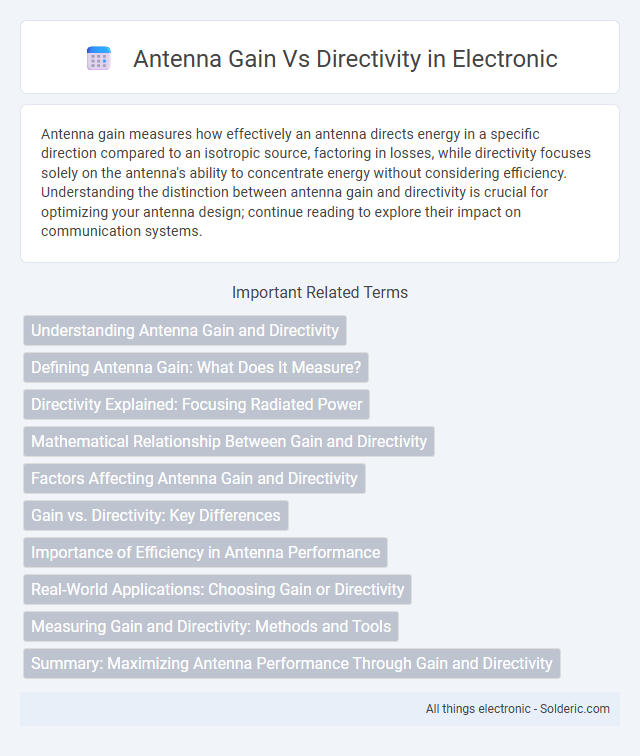Antenna gain measures how effectively an antenna directs energy in a specific direction compared to an isotropic source, factoring in losses, while directivity focuses solely on the antenna's ability to concentrate energy without considering efficiency. Understanding the distinction between antenna gain and directivity is crucial for optimizing your antenna design; continue reading to explore their impact on communication systems.
Comparison Table
| Parameter | Antenna Gain | Directivity |
|---|---|---|
| Definition | Measure of an antenna's ability to focus energy in a specific direction, including losses. | Measure of how concentrated the radiation pattern is in a particular direction, excluding losses. |
| Unit | Dimensionless ratio or decibels (dBi/dBd) | Dimensionless ratio or decibels (dBi) |
| Influenced By | Directivity and efficiency (losses, mismatches) | Radiation pattern shape only |
| Formula | Gain = Directivity x Efficiency | Directivity = Maximum radiation intensity / Average radiation intensity |
| Typical Values | Less than or equal to directivity; includes efficiency impact | Always greater than or equal to gain; idealized value without loss |
| Use Case | Predicts actual antenna performance in real systems | Assesses theoretical focusing ability of the antenna |
Understanding Antenna Gain and Directivity
Antenna gain measures how well an antenna converts input power into radio waves in a specific direction, combining directivity and efficiency. Directivity indicates the focus of the antenna's radiation pattern without accounting for losses, reflecting how concentrated the signal is in a particular direction. Understanding these concepts helps you optimize your antenna system for better signal strength and coverage.
Defining Antenna Gain: What Does It Measure?
Antenna gain quantifies how well an antenna converts input power into radio waves in a specific direction, combining both directivity and efficiency factors. Unlike directivity, which measures the concentration of radiated power in a particular direction regardless of losses, antenna gain accounts for real-world inefficiencies such as resistive and dielectric losses. This makes antenna gain a comprehensive metric for evaluating an antenna's performance in transmitting or receiving signals.
Directivity Explained: Focusing Radiated Power
Directivity measures how concentrated an antenna's radiated power is in a specific direction compared to an isotropic radiator. High directivity means the antenna focuses energy into a narrow beam, increasing signal strength toward the desired target. Your antenna's gain factors in efficiency losses, but directivity purely quantifies the focused radiation pattern without considering power loss.
Mathematical Relationship Between Gain and Directivity
Antenna gain (G) and directivity (D) are closely related by the equation G = eD, where e represents the antenna efficiency, typically ranging between 0 and 1. Directivity measures the concentration of radiated power in a specific direction, while gain accounts for the efficiency and losses in the antenna system. This mathematical relationship highlights that gain is the product of the directive properties of the antenna and its ability to convert input power into radiated power effectively.
Factors Affecting Antenna Gain and Directivity
Antenna gain and directivity are influenced by factors such as antenna size, shape, and operating frequency, which determine how effectively the antenna concentrates energy in a specific direction. The efficiency of the antenna material and surrounding environment also impacts gain by affecting power losses and signal strength. Your antenna's performance improves when these physical and environmental parameters are optimized, resulting in higher directivity and gain values.
Gain vs. Directivity: Key Differences
Antenna gain measures how effectively an antenna converts input power into radio waves in a specific direction, incorporating both directivity and efficiency. Directivity reflects the antenna's ability to focus energy in a particular direction without accounting for losses. Understanding the distinction between gain and directivity helps you optimize antenna performance for your communication system.
Importance of Efficiency in Antenna Performance
Antenna gain and directivity are closely related, but gain incorporates efficiency, making it a more practical measure of antenna performance. Efficiency accounts for losses due to resistance, impedance mismatch, and material imperfections, impacting the actual power radiated in a given direction. High directivity with low efficiency can result in poor gain, underscoring the critical role of efficiency in achieving effective antenna operation.
Real-World Applications: Choosing Gain or Directivity
In real-world applications, antenna gain is preferred when both directivity and efficiency impact signal strength, making it crucial for optimizing transmission in wireless communications and radar systems. Directivity is ideal for applications requiring focused beam patterns, such as satellite communication and point-to-point microwave links, where minimizing interference and maximizing signal focus is essential. Balancing gain and directivity ensures efficient energy use and reliable performance in diverse environments, from mobile networks to deep-space communication.
Measuring Gain and Directivity: Methods and Tools
Measuring antenna gain involves using calibrated reference antennas and signal generators to compare transmitted or received power levels, ensuring accurate gain calculation in decibels (dBi). Directivity measurement relies on radiation pattern analysis, often performed with anechoic chambers and near-field scanning systems to map the antenna's spatial radiation distribution. You can utilize vector network analyzers (VNAs) combined with specialized software to conduct precise measurements of both gain and directivity for optimal antenna performance evaluation.
Summary: Maximizing Antenna Performance Through Gain and Directivity
Antenna gain and directivity are crucial parameters defining antenna performance by measuring its ability to focus energy in a specific direction. Higher directivity concentrates the radiated power, enhancing signal strength and reception quality, while gain incorporates both directivity and antenna efficiency to represent overall performance. Optimizing your antenna design involves balancing gain and directivity to achieve maximal signal clarity and effective communication range.
antenna gain vs directivity Infographic

 solderic.com
solderic.com